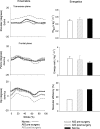Gait in thoracolumbar/lumbar adolescent idiopathic scoliosis: effect of surgery on gait mechanisms
- PMID: 20148341
- PMCID: PMC2900025
- DOI: 10.1007/s00586-010-1292-2
Gait in thoracolumbar/lumbar adolescent idiopathic scoliosis: effect of surgery on gait mechanisms
Abstract
For patients whose scoliosis progresses, surgery remains the ultimate way to correct and stabilise the deformity while maintaining as many mobile spinal segments as possible. In thoracolumbar/lumbar adolescent idiopathic scoliosis (AIS), the spinal fusion has to be extended to the lumbar spine. The use of anterior spinal fusion (ASF) instead of the classic posterior fusion (PSF) may preserve more distal spinal levels in attempt to limit the consequences of surgery on trunk mobility. The effects of surgery on body shape, pain and the decompensation phenomenon have all been well evaluated. Very few studies have addressed the effect of ASF or PSF on basic activities, such as walking. Before any treatment, AIS patients already have reduced pelvis, hip and shoulder motion when walking at a normal speed compared with adolescents without scoliosis (control group). Additionally, they have longer contraction time of the lumbar and pelvic muscles leading to an excessive energy cost and reduced muscle efficiency. In addition, if these changes are associated with spinal stiffness, spinal fusion could further negatively affect this pre-surgical inefficient walk. The goals of this study were (a) to compare pre- and 1-year post-surgery conditions in order to assess the effects of spinal arthrodesis on gait parameters and (b) to compare the anterior versus the posterior surgical approaches. Nineteen young females with thoracolumbar/lumbar AIS were assessed by radiological and clinical examination and by conventional gait analysis before surgery and at almost 12 months after surgery. Seven subjects underwent surgery using ASF and 12 using PSF. Three-dimensional gait analysis was performed on a motor-driven treadmill at spontaneous self-selected speed to record kinematic, electromyographic (EMG), mechanical and energetic measurements synchronously. Although it was expected that the instrumentation would modify the characteristics of normal walking, this study showed that surgery does not induce asymmetric gait or any significant differences between the ASP and the PSF surgery groups. One year after surgery, the changes observed consisted of improvements in the gait and mechanical parameters. In the PSF group, 11-14 vertebrae were fused while only 3-4 were fused in the ASF group. In both AIS groups, step length was increased by 4% and cadence reduced by 2%. There was a slight increase in pelvis and hip frontal motion. Only the transverse shoulder motion was mildly decreased by 1.5 degrees . All the other gait parameters were left unchanged or were improved by surgery. Notably, the EMG timing activity did not change. The total muscular mechanical work (W (tot)) increased by 6% mainly due to the external work (W (ext)), i.e. the work performed by the body muscles to move the body in its surroundings. The energy cost, although showing a tendency towards a reduction, remained globally excessive, probably due to the excessive co-contraction of the lumbo-pelvic muscles.
Figures


Similar articles
-
Gait in adolescent idiopathic scoliosis: energy cost analysis.Eur Spine J. 2009 Aug;18(8):1160-8. doi: 10.1007/s00586-009-1002-0. Epub 2009 Apr 24. Eur Spine J. 2009. PMID: 19390877 Free PMC article.
-
Anterior spinal fusion versus posterior spinal fusion for moderate lumbar/thoracolumbar adolescent idiopathic scoliosis: a prospective study.Spine (Phila Pa 1976). 2008 Sep 15;33(20):2166-72. doi: 10.1097/BRS.0b013e318185798d. Spine (Phila Pa 1976). 2008. PMID: 18794757
-
Radiographic outcomes of anterior spinal fusion versus posterior spinal fusion with thoracic pedicle screws for treatment of Lenke Type I adolescent idiopathic scoliosis curves.Spine (Phila Pa 1976). 2005 Aug 15;30(16):1859-66. doi: 10.1097/01.brs.0000174118.72916.96. Spine (Phila Pa 1976). 2005. PMID: 16103856
-
Surgical Treatment of Scoliosis Lenke Type 5, Anterior Versus Posterior, Which Approach is Better?: A Systematic Review and Meta-Analysis.Spine (Phila Pa 1976). 2023 Jul 15;48(14):E223-E234. doi: 10.1097/BRS.0000000000004529. Epub 2022 Nov 1. Spine (Phila Pa 1976). 2023. PMID: 36730847
-
Segmental range-of-motion by vertebral level in fused and unfused patients with adolescent idiopathic scoliosis: a systematic review of the literature.Spine Deform. 2025 Jan;13(1):29-41. doi: 10.1007/s43390-024-00978-w. Epub 2024 Sep 29. Spine Deform. 2025. PMID: 39342538 Free PMC article.
Cited by
-
Asymmetrical trunk movement during walking improved to normal range at 3 months after corrective posterior spinal fusion in adolescent idiopathic scoliosis.Eur Spine J. 2018 Feb;27(2):388-396. doi: 10.1007/s00586-017-5369-z. Epub 2017 Dec 7. Eur Spine J. 2018. PMID: 29218483
-
Scoliosis: lower limb asymmetries during the gait cycle.Arch Physiother. 2015 Jul 8;5:4. doi: 10.1186/s40945-015-0001-1. eCollection 2015. Arch Physiother. 2015. PMID: 29340173 Free PMC article.
-
Center of pressure progression patterns during level walking in adolescents with idiopathic scoliosis.PLoS One. 2019 Apr 22;14(4):e0212161. doi: 10.1371/journal.pone.0212161. eCollection 2019. PLoS One. 2019. PMID: 31009471 Free PMC article.
-
Does Vertical Ground Reaction Force of the Hip, Knee, and Ankle Joints Change in Patients with Adolescent Idiopathic Scoliosis after Spinal Fusion?Asian Spine J. 2018 Apr;12(2):349-355. doi: 10.4184/asj.2018.12.2.349. Epub 2018 Apr 16. Asian Spine J. 2018. PMID: 29713418 Free PMC article.
-
Efficacy of Corrective Surgery for Gait and Energy Expenditure in Patients with Scoliosis: A Literature Review.Asian Spine J. 2018 Oct;12(5):951-965. doi: 10.31616/asj.2018.12.5.951. Epub 2018 Sep 10. Asian Spine J. 2018. PMID: 30213180 Free PMC article.
References
-
- Bernstein RM, Hall JE. Solid rod short segment anterior fusion in thoracolumbar scoliosis. J Pediatr Orthop B. 1998;7:124–131. - PubMed
Publication types
MeSH terms
LinkOut - more resources
Full Text Sources
Medical

